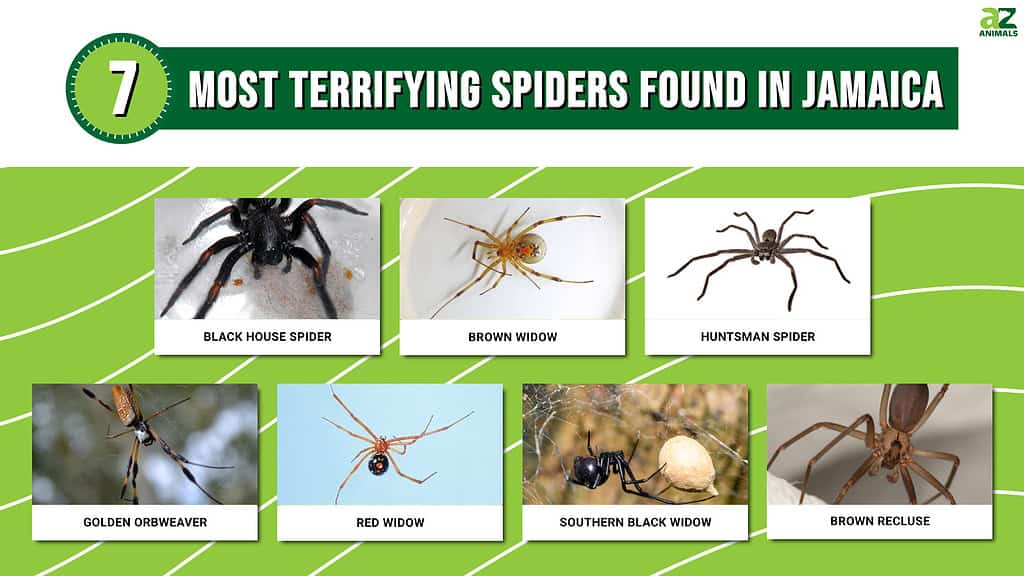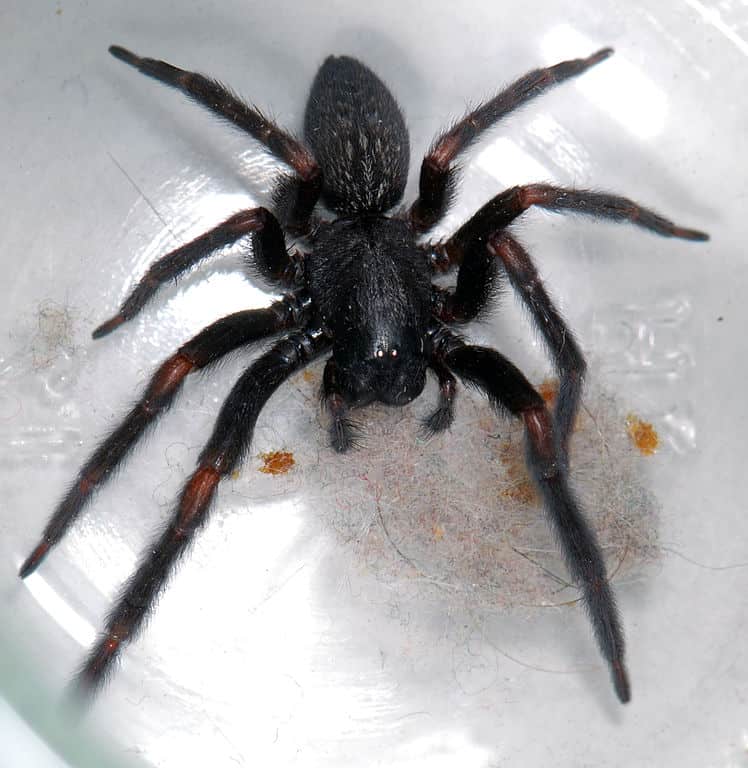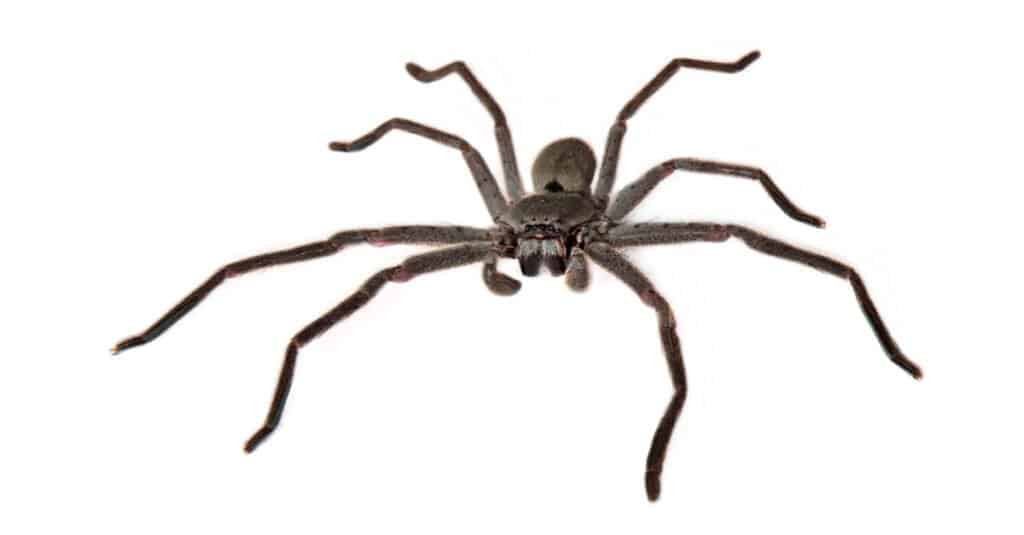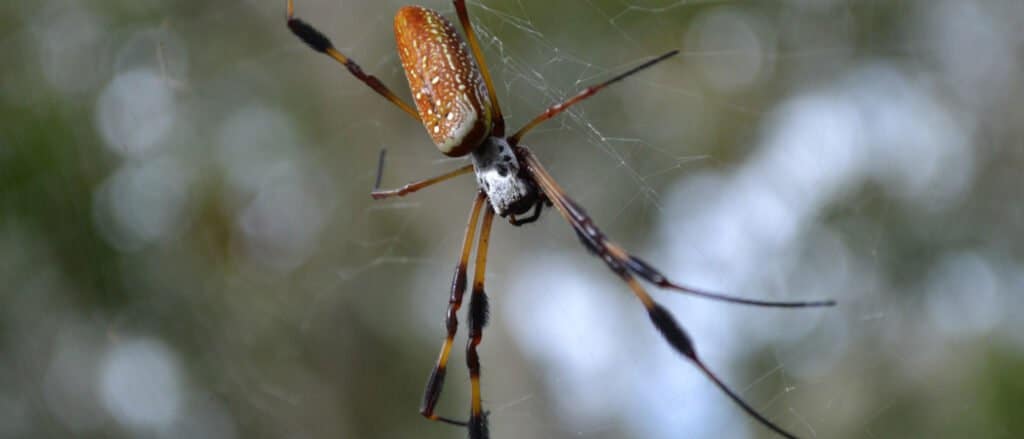Spiders are abundant around the world, with more than 50,000 species identified. Each year brings with it the discovery of hundreds of new spider species. These arachnids inhabit every continent except Antarctica. Here you will discover seven terrifying spiders found in Jamaica, which make up just a handful of those living on the island.
Coming across a large spider can be shocking! However, while size may be intimidating, it is not an indication of danger. The majority of spiders’ venom is not medically significant. The most common symptoms of spider bites include redness and mild swelling. Death from a spider bite is extremely rare, but you should be vigilant regarding certain species that possess strong venom.

Learning about spiders will put you at ease, as most are harmless. But for many people, even spiders with weak venom are frightening! And if you are allergic to their venom, their bites may cause a severe reaction. Let’s take a look at a few terrifying spiders found in Jamaica!
1. Black House Spider (Badumna insignis)

This spider is black, with greyish markings on its abdomen, and their legs are sometimes brown.
©Peter Halasz (User:Pengo) / CC BY-SA 2.5 – License
Though the black house spider inhabits Jamaica, it is native to Australia. This spider has also been introduced to other areas of the world, like New Zealand and Japan. As their name suggests, black house spiders often live in homes. Homeowners spot these spiders on windowsills and in secluded corners, where they build messy silk webs.
This spider is black, with greyish markings on its abdomen. Their legs are sometimes brown. Blackhouse spiders’ body size range between 0.39 to 0.7 inches. Including their legs, this spider reaches up to 1.18 inches in size.
Because insects attract this spider, they may sometimes build their homes near light sources. Blackhouse spiders are timid, and they rarely bite. However, reported bites from this species caused swelling, sweating, vomiting, along with mild necrosis after multiple bites.
2. Brown Widow (Latrodectus geometricus)

Their legs have banded black and tan markings, while the underside of the abdomen features a red hourglass.
©Decha Thapanya/Shutterstock.com
Brown widow spiders are common in warm, and humid environments, like Jamaica. They are believed to be native to southern Africa but were first documented in South America. But this species has invasive tendencies. They build messy webs under toys, outdoor furniture, and other secluded areas.
While a relative of the black widow, this spider is brown. They have a mottled tan coloring on their abdomen, with a black head. Their legs have banded black and tan markings. Brown widow spiders are around 1.5 to 2 inches in size. Like other widow spiders, this species has a red hourglass on its underside.
Compared to other widow spiders, the brown widow’s bite is weak. Studies analyzing the bite effects of widow spiders reveal bites from the brown widow cause fewer symptoms. Interestingly, experts believe the brown widow’s venom is just as potent as the black widow’s venom. However, brown widow bites cause fewer symptoms because they inject less venom.
3. Huntsman Spiders (Neostasina spp.)

The biggest huntsman spiders have a body size of around 1 inch, with their leg span reaching around 3 to 5 inches!
©John McQueen/Shutterstock.com
Huntsman spiders are some of the largest spiders in the world. These giants live on tree trunks, under stones, and on the sides of houses. Tan is the most common color for these spiders, and their legs are their largest feature. The biggest huntsman spiders have a body size of around 1 inch, with their leg span reaching around 3 to 5 inches!
Active at night, huntsman spiders spend their time hunting for small insects and invertebrates. Named for their adept hunting ability, they use their speed and excellent eyesight to track and take down prey. Huntsman spiders are not dangerous to humans, and despite their massive size, they are docile.
4. Golden Orbweaver (Nephila clavipes)

As adults, females of this black and yellow species range between 2 to 6 inches in size.
©Natalie Gail/Shutterstock.com
Out of all the spiders found in Jamaica, the golden orbweaver may be one of the most elegant. Like other orbweavers, females build large webs up to 2 feet wide. Their silk is quite beautiful, as it shines a golden hue in the sun. Golden orbweavers live in forest habitats and warm environments.
Golden orbweavers can grow to be even larger than the huntsman spider. As adults, females range between 2 to 6 inches in size. Males are much smaller and rarely seen, and at most grow to be 2 inches. These spiders have an elongated abdomen, with long spindly legs. Their bodies are yellow or black with white spots. Their legs have bands of yellow, black, and red.
Active in the day, this spider sits in its web and waits for insects to fall into their silk. The yellow coloring of their webs is effective at luring insects. When prey falls into its web, the spider ambushes it and neutralizes it with venom.
5. Red Widow (Latrodectus bishopi)

Their bulbous abdomen is black, with red blotches and yellow or cream markings.
©Florida Division of Plant Industry Archive / CC BY 3.0 US, via Wikimedia Commons – License
The red widow is one of the few types of Latrodectus spiders in Jamaica. These spiders are native to southern Florida and enjoy regions with humid and warm temperatures. Red widows are common in vegetation like trees or bushes. Like other spiders within their family, this species builds messy tangled webs.
Red widows, like other widow spiders, have a bulbous abdomen with spindly legs. Their abdomen is black, with red blotches and yellow or cream markings. The cephalothorax and legs are an orangish red color.
The venom from the red widow is dangerous, as is the case with most other Latrodectus spiders. Bites are rare due to this species’ tendency to avoid areas where humans live. In fact, there are no reports of red widow bites in medical literature. Red widows feed on insects like flies, crickets, and beetles.
6. Southern Black Widow (Latrodectus mactans)

Black widows are sexually dimorphic, and only females are dangerous.
©Jeff W. Jarrett/Shutterstock.com
Southern black widows are one of the most dangerous spiders in Jamaica. These spiders are most active during warm months, and they are a nocturnal species. They fashion messy webs, created with strong silk. Southern black widows hide near their webs during the day, and at night, they wait in their silk for prey to fall into their sticky trap.
Black widows are sexually dimorphic, and only females are dangerous. Males are much smaller, with brown, white, and black coloring. Females have a jet-black appearance and very bulbous abdomens. Juvenile females may have red or white markings, which change to all-black as they continue to molt.
These infamous spiders are identified by a red hourglass on their underside. Many see this sign as a warning. Black widows have strong venom used to neutralize insect prey. It is medically significant, and if bitten, people may show symptoms of Latrodectism. Fever, sweating, nausea, and muscle aches are common.
7. Brown Recluse (Loxosceles reclusa)

Notorious for its powerful necrotic venom, brown recluses are one of the most dangerous spiders in Jamaica.
©Nick626/Shutterstock.com
The brown recluse is notorious for its powerful necrotic venom. Brown recluses are one of the most dangerous spiders in Jamaica. They are tan, with a distinct dark violin marking on their cephalothorax.
In Jamaica, this spider is found in quiet and secluded areas. They can make their way indoors and live in places like basements, attics, or garages. Brown recluse spiders are nocturnal and spend their nights looking for small insects to eat.
Loxoscelism is a term that is used to describe the envenomation and illness caused by the brown recluse. Their bites cause symptoms like necrosis, fever, and chills. If bitten, you should seek medical treatment immediately.
Summary Of The 7 Most Terrifying Spiders Found In Jamaica
| # | Spider | Venomous to Humans? |
|---|---|---|
| 1 | Black House Spider | Yes |
| 2 | Brown Widow | Yes |
| 3 | Huntsman Spider | Yes but mild |
| 4 | Golden Orbweaver | No |
| 5 | Red Widow | Yes |
| 6 | Southern Black Widow | Yes |
| 7 | Brown Recluse | Yes |
Bonus: What Keeps Spiders Away

Essential oil scents like lavender are repugnant to spiders.
©botamochi/iStock via Getty Images
One of a person’s worst nightmares is having spiders wind up in their home–especially the poisonous kind! The best way to avoid getting bitten by a spider is to try and prevent them from entering your house in the first place. As spiders can get into your home through holes and cracks, you can check for possible entryways with a flashlight. If the light gets through from the inside to the outside, you should fill that hole or crevice with an appropriate product.
Keeping your yard free of debris and overgrown vegetation helps cut down on areas spiders would gravitate to. Caulking doors and windows is also a good strategy to keep them out.
Spiders hate certain scents, so scented essential oils can help deter them like peppermint, tea-tree, lavender, and rose. You can add 15-20 drops of a particular oil in a water bottle mixed with water and spritz it around your house. They also hate the smell of cinnamon and vinegar, so these scents can be used similarly.
Rubbing lemon or orange peels on the baseboards along your walls, on window sills, and on other surfaces can also repel spiders, who dislike citrus smells. Furniture polish and cleaning products with lemon scent can also help.
Regular cleaning inside your home, especially in areas that are dark or less frequented, is necessary to keep spiders from setting up residence. It’s also important to keep an eye on fruit bowls, as they can attract spiders.
The photo featured at the top of this post is © Pong Wira/Shutterstock.com
Thank you for reading! Have some feedback for us? Contact the AZ Animals editorial team.






